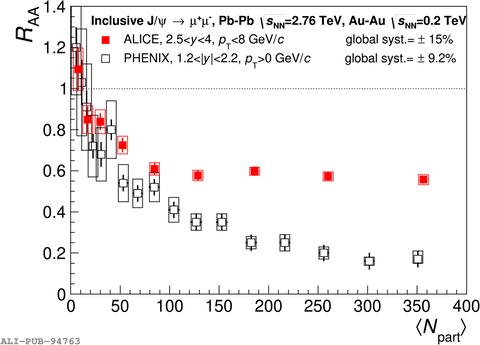Melting and re-binding charmonium
Two types of quarkonia have been extensively studied: charmonia, which consist of a charm quark and an anti-charm, and bottomonia made of a bottom and an anti-bottom quark.Charm and anticharm quarks in the presence of the Quark Gluon Plasma, in which there are many free colour charges, are not able to see each other any more and therefore they cannot form bound states. The "melting" of quarkonia into the QGP manifests itself in the suppression of the quarkonium yields compared to the production without the presence of the QGP. The search for quarkonia suppression as a QGP signature started in the 1990s.

As the temperature increases so does the colour screening resulting in greater suppression of the quarkonium states as it is more difficult for charm – anticharm or bottom – antibottom to form new bound states. At very high temperatures no quarkonium states are expected to survive; they melt in the QGP. Quarkonium sequential suppression is therefore considered as a QGP thermometer, as states with different masses have different sizes and are expected to be screened and dissociated at different temperatures. However - as the collision energy increases - so does the number of charm-anticharm quarks that can form bound states, and a balancing mechanism of recombination of quarkonia may appear as we move to higher energies.
The results from ALICE at the LHC are rather striking, when compared with the observations from lower energies (left-hand panel of the figure, from Phys.Rev.Lett. 109 (2012) 072301). In peripheral collisions a similar suppression is observed at RHIC energy (c.m.s. energy of 200 GeV) and at LHC energies. When moving towards more head-on collisions – as quantified by the increasing number of nucleons in the lead nuclei participating in the interaction – the suppression is reduced at LHC with respect to the lower energy case . Therefore, despite the higher temperatures attained in the nuclear collisions at the LHC, more J/ψ mesons are detected by the ALICE experiment in Pb–Pb with respect to p–p. This effect is likely to be related to a regeneration (or re-binding) process occurring at the temperature boundary between the QGP and a hot gas of hadrons. A confirmation of this scenario comes from the comparison of ALICE measurements as a function of J/ψ transverse momentum at central and forward rapidity (right-hand panel of the figure, from Phys.Lett.B 805 (2020) 135434): the suppression of J/ψ is largest at high transverse momentum, where the regeneration probability is small, and decreases at low transverse momentum and central rapidity, where charm and anticharm pairs are more abundant and thus more likely to re-bind to form a J/ψ meson.


